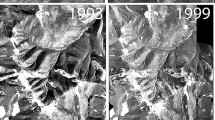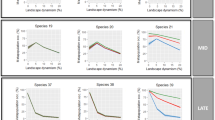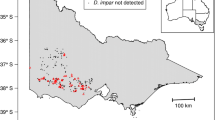Abstract
The importance of considering spatially-correlated extinction in metapopulation viability analyses was investigated using a model of the population dynamics of Gymnobelideus leadbeateri McCoy (Leadbeater's Possum). Fire caused local extinction of G. leadbeateri and induced changes in the suitability of the habitat over a period of decades and centuries. Spatially-correlated fires, in which the correlation between the incidence of fire declines with distance, and uniformly-correlated fires were simulated. The predicted risk of metapopulation extinction increased: (i) as the variance in the number of fires each year increased, (ii) as the mean fire interval decreased, and (iii) as the mean dispersal distance decreased. Incorporating spatial correlation in the incidence of fires between patches had little effect on the results, provided the variance in the number of fires per year remained the same and fires modified habitat quality. The predicted risk of metapopulation extinction was greater for spatially-correlated fires than for uniformly-correlated fires when fires only caused local extinction but did not change habitat suitability. Incorporating spatial correlation in the incidence of fire within patches, which allowed partial burning of patches, reduced the predicted risk of extinction. This effect was only slight when patches were smaller than about 50 ha. The results of our simulations demonstrate the importance of considering correlations in disturbance regimes in metapopulation models, especially if these models are used to assist the design of nature reserves.
Similar content being viewed by others
References
Adams MA and Attiwill PM (1984) Role of Acacia spp. in nutrient balance and cycling in regenerating Eucalyptus regnans F. Muell. forests. I Temporal changes in biomass and nutrient content. Australian Journal of Botany 32: 205–215
Akçakaya HR, Pearce JL and McCarthy MA (1995) Linking landscape data with population viability analysis: management options for the helmeted honeyeater Lichenostomus melanops cassidix. Biological Conservation 73: 169–176
Ashton DH (1981) Fire in tall open forests. In: Gill AM, Groves RH and Noble IR (eds) Fire and the Australian Biota, pp 339–366. Australian Academy of Science, Canberra
Burgman MA, Ferson S and Akçakaya HR (1993) Risk Assessment in Conservation Biology. Chapman & Hall, London
Emrich LJ and Piedmonte MR (1991) A method for generating high-dimensional multivariate binary variables. American Statistician 45: 302–304
Forman TT (1996) Land mosaics. The Ecology of Landscapes and Regions. Cambridge University Press, New York
Gilpin ME (1990) Extinction in finite metapopulations living in correlated environments. In: Shorrocks B and Swingland IR (eds) Living in a Patchy Environment, pp 177–187. Oxford University Press, New York
Gilpin ME (1992) Demographic stochasticity: a Markovian approach. Journal of Theoretical Biology 154: 1–8
Hanski I (1994) Patch-occupancy dynamics in fragmented landscapes. Trends in Ecology and Evolution 9: 131–135
Harrison S and Quinn JF (1989) Correlated environments and the persistence of metapopulations. Oikos 56: 293–298
Levins R (1970) Extinction. In: Gerstenhaber M (ed) Some Mathematical Questions in Biology, pp 75–108. Providence, American Mathematical Society, Rhode Island
Lindenmayer DB (1996) Wildlife and Woodchips. University of New South Wales Press, Sydney
Lindenmayer DB and Possingham HP (1995) Modelling the impacts of wildfire on the viability of metapopulations of the endangered Australian species of arboreal marsupial, Leadbeater's possum. Forest Ecology and Management 74: 197–222
Lindenmayer DB, Cunningham RB, Tanton MT, Nix HA and Smith AP (1991a) The conservation of arboreal marsupials in the montane ash forests of the Central Highlands of Victoria, south-east Australia. III. The habitat requirements of Leadbeater's Possum, Gymnobelideus leadbeateri and models of the diversity and abundance of arboreal marsupials. Biological Conservation 56: 295–315
Lindenmayer DB, Cunningham RB, Tanton MT, Smith AP and Nix HA (1991b) Characteristics of hollowbearing trees occupied by arboreal marsupials in the montane ash forests of the Central Highlands of Victoria, south eastern Australia. Forest Ecology and Management 40: 289–308
Lindenmayer DB, Cunningham RB, Donnelly CF, Tanton MT and Nix HA (1993) The abundance and development of cavities in montane ash-type eucalypt trees in the montane forests of the Central Highlands of Victoria, south-eastern Australia. Forest Ecology and Management 60: 77–104
Lindenmayer DB, Cunningham RB and Donnelly CF (1994) The conservation of arboreal marsupials in the montane ash forests of the Central Highlands of Victoria, south-east Australia. VI. Tests of the performance of models of nest tree and habitat requirements of arboreal marsupials. Biological Conservation 70: 143–147
Lindenmayer DB, Burgman MA, Akçakaya HR, Lacy RC and Possingham HP (1995) Computation and understanding in modelling metapopulations of wildlife: a review of three generic computer models-ALEX, RAMAS/space and VORTEX. Ecological Modelling 82: 161–174
Lindenmayer DB, Cunningham RB and Donnelly CF (1997) Tree decline and collapse in Australian forests: implications for arboreal marsupials. Ecological Applications 7: 625–641
McCarthy MA (1996) Extinction dynamics of the helmeted honeyeater: effects of demography, stochasticity, inbreeding and spatial structure. Ecological Modelling 85: 151–163
McCarthy MA, Franklin DC and Burgman MA (1994) The importance of demographic uncertainty: an example from the helmeted honeyeater Lichenostomus melanops cassidix. Biological Conservation 67: 135–142
McCarthy MA and Lindenmayer DB (1998) Multi-aged mountain ash forest, wildlife management and timber harvesting. Forest Ecology and Management 104: 43–56
McCarthy MA and Lindenmayer DB (1999) Incorporating meta-population dynamics of greater gliders into reserve design in disturbed landscapes. Ecology 80: 651–667
McCarthy MA and Lindenmayer DB (in press) Conservation of the greater glider (Petauroides volans) in remnant vegetation within exotic plantation forest. Animal Conservation
McCarthy MA, Gill AM and Lindenmayer DB (in press). Fire regimes in mountain ash forests: evidence from forest age structure, extinction models and wildlife habitat. Forest Ecology and Management
Morrison ML, Marcot BG and Mannan RW (1992) Wildlife Habitat Relationships: Concepts and Applications. University of Wisconsin Press, Madison
Portales GL, Reyes P, Rangel H, Velazquez A, Miller P, Ellis S and Smith AT (1997) Taller international para la conservacion de los Lagomorphos Mexicanos en peligro de extinction (International workshop on the conservation of Mexican Lagomorphs in danger of extinction). IUCN/CBSG. Apple Valley, Minnesota
Possingham HP and Davies I (1995) ALEX: a model for the viability analysis of spatially structured populations. Biological Conservation 73: 143–150
Seagle SW and Shugart HH (1985) Faunal richness and turnover on dynamic landscapes: a simulation study. Journal of Biogeography 15: 759–774
Shaffer M (1987) Minimum viable populations: coping with uncertainty. In: Soulé ME (ed) Viable Populations for Conservation, pp 69–86. Cambridge University Press, Cambridge
Smith AT and Gilpin ME (1997) Spatially correlated dynamics in a pika metapopulation. In: Hanski IA and Gilpin ME (eds) Metapopulation Biology: Ecology, Genetics, and Evolution, pp 407–428. Academic Press, San Diego, California
Smith RB and Woodgate P (1985) Appraisal of fire damage for timber salvage by remote sensing in Mountain Ash forests. Australian Forestry 48: 252–263
Tilman D, May RM, Lehman CL and Nowak MA (1994) Habitat destruction and the extinction debt. Nature 371: 65–66
Wiens JA (1997) Metapopulation dynamics and landscape ecology. In: Hanski IA and Gilpin ME (eds) Metapopulation Biology: Ecology, Genetics, and Evolution, pp 43–62. Academic Press, San Diego, California
Author information
Authors and Affiliations
Rights and permissions
About this article
Cite this article
McCarthy, M.A., Lindenmayer, D.B. Spatially-correlated extinction in a metapopulation model of Leadbeater's Possum. Biodiversity and Conservation 9, 47–63 (2000). https://doi.org/10.1023/A:1008953426795
Issue Date:
DOI: https://doi.org/10.1023/A:1008953426795




